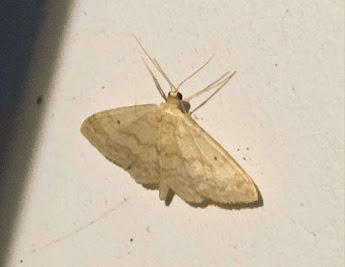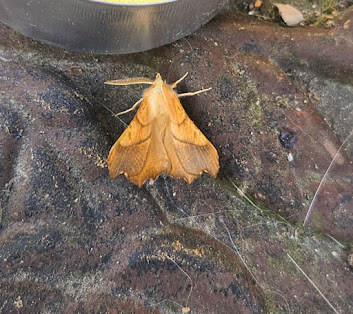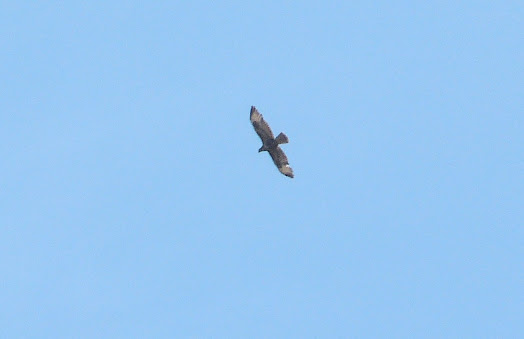Wednesday 2nd July 2025.
One of two August Thorn moths this morning by my Moth Box.
Rain was forecast this morning and as I entered the garden, it was heavily overcast and by 5.45am, the first drops of rain then did fall, so I had to hurry up in checking all the egg trays before I got a soaking. Yesterday's hot weather definitely brought in the Moths as both myself and Emma & Matt’s Moth Boxes were swarming with Moths! On my first shift at Pembroke Road, the rain got a little heavier, but it was still warm with temperatures hovering around the 18 degree centigrade mark, which was reasonably comfortable, despite wearing the heavy wet-weather coat.
My Moth Box:
One of two Large Tabby moths in the Moth Box today.
An incredible number of Moths recorded this morning, with at least 186 moths of 60 species of which easily smashed my year record and took nearly 90 minutes to go through the moths. To be honest, I am still finding a few extra moths dotted around including a Black Arches moth in the downstairs loo! Of the macro moths, there was an incredible SEVEN moths that were new for the year and that included two species I have only ever encountered once before: two Large Tabby’s of which the only one I have ever seen was one I found at Portchester Crematorium a few years back. A Small Emerald was also the second one I have ever seen and that was last year along the Canal Walk at Titchfield Haven one evening with Emma and Matt Parkes.
Above, new for the year was this smart Campion moth and below another newby was this Marbled Beauty.
Above, one of two Common Footman moths and below, my first Marbled Green of the year.
Other macro moths that were new for the year included both Marbled Green and Marbled Beauty (both annual to my garden), both August and September Thorn (again, both annual) and a Campion moth, which most certainly isn't annual with only a handful of records. The only micro that was new for the year was a Common Masoner (Blastobasis adustella), which is common in my garden in the summer months. A Satin Grass-moth (Crambus perlella) was my second for the year after finding a few on Martin Down earlier this year.
Above, my second Nut-tree Tussock of the year and the first one in my garden for the year and below, my first Common Masoner (Blastobasis adustella) of the year.
Above, this Satin Grass-moth (Crambus perlella) was the first in my garden this year and below, I just managed to grab a photo of this September Thorn moth before it flew off to the back of the garden.
Also present in and around my Moth Box were two Harlequin Ladybirds, about a dozen Lacewing and a few insects I am not quite sure of, but will do some research later for an ID. Yesterday, fellow ‘Moth-er’ Ian Thirlwell had a Passenger moth in his trap, a very rare immigrant moth from Southern Europe. I heard a Curlew flying overhead and sure enough, I picked it out within a grey sky heading south towards the sea.
The rare immigrant moth from the Continent, The Passenger. Photo by Ian Thirlwell.
The Moths recorded this morning included the following:
Macro moths: Micro moths:
Double-striped Pug x6 Privet Tortrix x2
Channel Islands Pug x1 Netted Tortrix x1
Lime-speck Pug x5 Garden Grass-veneer x13
Large Tabby x2 * Meal Moth x1
Silver Y x8 Blushed Knot-horn x3
Dark Arches x5 Bud Moth x2
Black Arches x1 Ruddy Streak x2
L-album Wainscot x2 Elderberry Pearl x2
Garden Carpet x2 Common Masoner x1 *
Small Dusty Wave x1 Rusty-dot Pearl x3
Small Emerald x1 * Bird-cherry Ermine x24
Common Emerald x2 Willow Ermine x1
Marbled Beauty x1 * Rosy Tabby x3
Marbled Green x1 * Box Tree Moth x2
Riband Wave x21 Large Pale Masoner x4
Pale Mottled Willow x2 Garden Grey x5
Large Yellow Underwing x3 Barred Yellowneck x1
Lesser Broad-bordered Yellow Underwing x1
Lesser Yellow Underwing x3 Mint Moth x1
Willow Beauty x5 Bee Moth x2
Dusky Sallow x1 Common Plume x3
White Ermine x2 White-banded Grass-moth x2
Heart & Dart x5 Black-banded Masoner x1
Nut-tree Tussock x1 Satin Grass-moth x1
August Thorn x1 * Oak Knot-horn x1
September Thorn x1 * Brown Bark Moth x1
Common Footman x2
Dun-bar x1
Lackey x6
Uncertain x1
Campion x1 *
Bright-line Brown-eye x3
Swallow-tailed Moth x1
Plumed Fan-foot x1
Matt & Emma’s Moth Box:
Matt & Emma had this superb Green Silver-lines in their Fareham garden this morning.
As Emma put it, it was simply crazy with Moths in their Fareham garden this morning with at least 38 species present. I have asked for them to count the moths, but that is me just being anal I suppose! Still, some incredible moths there, especially with the Green Silver-lines and Dotted Fan-foot; the latter I have never seen before.
Above, a Clouded Silver and below, the Dotted Fan-foot.
The Moths recorded in their garden this morning included the following:
Macro moths: Micro moths:
Double-striped Pug Dark-streaked Tortrix
Ruby Tiger Twenty-plume Moth
L-album Wainscot Tawny Grey
Willow Beauty Rosy Tabby
Small Fan-footed Wave Bee Moth
Dark Arches Hawthorn Moth
Blood-vein Garden Grass-veneer
Swallow-tailed Moth Ruddy Streak
Lesser Broad-bordered Yellow Underwing Garden Grey
Langmaid’s Yellow Underwing White-banded Grass-moth
Dun-bar Codling Moth
Dotted Fan-foot Garden Straw
Common Rustic agg. Grey Knot-horn
Riband Wave
Flame Shoulder
Maiden’s Blush
Scarce Footman
Scarce Silver-lines
Snout
Blair’s Mocha
Clouded Silver
Dusky Sallow
Coronet
Scalloped Oak
Flame
Pembroke Road, Old Portsmouth:
Overcast skies and some rain will help replenish the grass on Governor's Green. More rain is forecast for the weekend here on the south coast.
Up to 12 species of birds were noted this morning here in Old Portsmouth and although nothing was out of the ordinary, it was nice to have a bit of cooling rain coming down from a lead coloured sky. A few Swifts were seen and the usual Great Black-backed Gulls were on the rooftops near the Garrison Church. Hopefully, more will come in the afternoon shift. There were plenty of Harlequin Ladybirds on the Hibiscus Bushes and several Buff-tailed Bumblebees enjoying the flowers within the Bushes.
Both Black-headed and Mediterranean Gull were added to my day total here in Pembroke Road this afternoon on my second shift as the weather turned out warm and sunny again after this mornings rain. Back in my garden late this afternoon, both Large and Small White butterflies were enjoying my Lavender plants and a Red Admiral butterfly fluttered in and quickly out of the garden.

























































